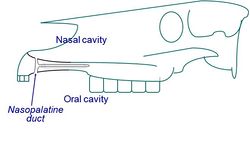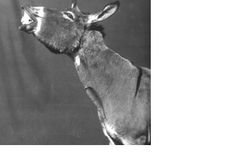Vomeronasal Organ
Overview
The vomeronasal organ is also known as the olfactory organ, or the Jacobson's organ. It is an olfactory sense organ that is found in most animals. It is positioned at the base of the nasal cavity, within the roof of the mouth, and is separated into two parts by the nasal septum. It is situated close to the vomer and nasal bones, hence the name vomeronasal organ. It is contained within a bony capsule which opens into the base of the nasal cavity, and is lined with olfactory mucosa. The vomeronasal organ contains sensory chemoreceptors, and is involved in the first processing step of the accessory olfactory system. The vomeronasal organ carries information via the olfactory nerve (CN I), which travels through the cribriform plate, to the accessory olfactory bulb (the vomeronasal bulb), and then to the hypothalamus. The sensory receptors are found on the medial inner surface of the vomeronasal organ. The lateral inner surface is covered with sensory cilia. Basal cells are also found in this region. The dorsal and ventral inner surfaces of the vomeronasal organ comprise the vomeronasal glands, which function to fill the organ with fluid.
Function
The function of the vomeronasal organ is carried out by the sensory chemoreceptors. They can detect specific chemical compounds, including pheromones (although pheromones can also be detected by the normal olfactory pathway). As the information that is picked up by the vomeronasal organ is sent to the accessory olfactory bulb and then the hypothalamus, as opposed to the olfactory bulb and then the cerebral cortex, this may explain why some specific chemical compounds within scents may induce aggressive or mating behaviour. It can also be used in kin recognition (e.g. lambs by their dam)
The Flehmen Reaction
The Flehmen reaction is a characteristic behaviour in animals which aids in the transfer of scents into the vomeronasal organ. It involves the curling of the upper lip and stretching of the neck, making the animal appear to be grimacing. The reaction encourages scents to move towards the vomeronasal organ, as air is pumped in and out of it, so the scents can be determined. It is often used by males when mating, in order to find a female in oestrus. In this instance, the male usually picks the scent up from the females urine. It can also be used to detect the presence of prey, for example.
Error in widget FBRecommend: unable to write file /var/www/wikivet.net/extensions/Widgets/compiled_templates/wrt66284b61a0a1e2_03400152 Error in widget google+: unable to write file /var/www/wikivet.net/extensions/Widgets/compiled_templates/wrt66284b61a3c454_16781726 Error in widget TwitterTweet: unable to write file /var/www/wikivet.net/extensions/Widgets/compiled_templates/wrt66284b61a69ea3_25551296
|
| WikiVet® Introduction - Help WikiVet - Report a Problem |

